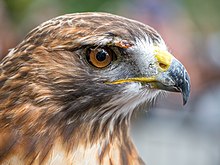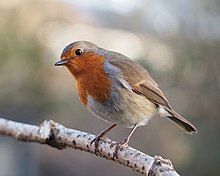Telluraves
| Telluraves | |
|---|---|

| |
| Red-tailed hawk (Buteo jamaicensis) | |

| |
| European robin, Erithacus rubecula | |
| Scientific classification | |
| Domain: | Eukaryota |
| Kingdom: | Animalia |
| Phylum: | Chordata |
| Class: | Aves |
| Clade: | Neoaves |
| (unranked): | Passerea |
| Clade: | Telluraves Yuri et al., 2013 |
| Clades | |
Telluraves (also called land birds or core landbirds) is a recently defined[2] clade of birds defined by their arboreality.[3] Based on most recent genetic studies, the clade unites a variety of bird groups, including the australavians (passerines, parrots, seriemas, and falcons) as well as the afroavians (including the Accipitrimorphae – eagles, hawks, buzzards, vultures etc. – owls and woodpeckers, among others).[4] This grouping was defined in the PhyloCode by George Sangster and colleagues in 2022 as "the least inclusive crown clade containing Accipiter nisus and Passer domesticus".[5] They appear to be the sister group of the Phaethoquornithes.[6]
Given that the most basal extant members of both Afroaves (Accipitrimorphae, Strigiformes) and Australaves (Cariamiformes,[7] Falconiformes) are birds of prey, it has been suggested that the last common ancestor of all Telluraves may have been an apex predator, and possibly also a bird of prey.[6] Other researchers are skeptical of this assessment, citing the herbivorous cariamiform Strigogyps as evidence to the contrary.[8]
Afroaves has not always been recovered as a monophyletic clade in subsequent studies.[9] For instance, Prum et al. (2015) recovered the accipitrimorphs as the sister group to a clade (Eutelluraves) comprising the remaining Afroavian orders and Australaves.,[10] while an analysis by Houde et al. (2019) recovered a clade of accipitrimorphs and owls as sister to the remaining landbirds.[11] Wu et al. (2024) also found recovered and found support the clade of accipitrimorphs and owls (which they have named Hieraves), but found the clade to be sister to Australaves, while Coraciimorphae is the basal most clade in Telluraves.[12]
The cladogram of the Telluraves shown below is based on the study by Josefin Stiller and collaborators published in 2024.[13] The species numbers are taken from the December 2023 version of the list maintained by Frank Gill, Pamela C. Rasmussen and David Donsker on behalf of the International Ornithological Committee (IOC). This list includes the Cathartiformes (New World vultures) in the order Accipitriformes.[14]
| Telluraves |
| ||||||||||||||||||||||||||||||||||||||||||||||||||||||||||||||||||||||||
References
[edit]- ^ Daniel T. Ksepka; Thomas A. Stidham; Thomas E. Williamson (2017). "Early Paleocene landbird supports rapid phylogenetic and morphological diversification of crown birds after the K–Pg mass extinction". Proceedings of the National Academy of Sciences of the United States of America. 114 (30): 8047–8052. Bibcode:2017PNAS..114.8047K. doi:10.1073/pnas.1700188114. PMC 5544281. PMID 28696285.
- ^ Yuri, T.; Kimball, R.T.; Harshman, J.; Bowie, R.C.K.; Braun, M.J.; Chojnowski, J.L.; Han, K.-L.; Hackett, S.J.; Huddleston, C.J.; Moore, W.S.; Reddy, S.; Sheldon, F.H.; Steadman, D.W.; Witt, C.C.; Braun, E.L. (2013). "Parsimony and model-based analyses of indels in avian nuclear genes reveal congruent and incongruent phylogenetic signals". Biology. 2 (1): 419–444. doi:10.3390/biology2010419. PMC 4009869. PMID 24832669.
- ^ Crouch, N.M.A.; Ramanauskas, K.; Igić, B. (2019). "Tip-dating and the origin of Telluraves". Molecular Phylogenetics and Evolution. 131: 55–63. Bibcode:2019MolPE.131...55C. doi:10.1016/j.ympev.2018.10.006. PMID 30385308. S2CID 53767029.
- ^ Ericson, P. G. (2012). "Evolution of terrestrial birds in three continents: biogeography and parallel radiations" (PDF). Journal of Biogeography. 39 (5): 813–824. Bibcode:2012JBiog..39..813E. doi:10.1111/j.1365-2699.2011.02650.x. S2CID 85599747. Archived from the original (PDF) on 2017-08-30.
- ^ Sangster, George; Braun, Edward L.; Johansson, Ulf S.; Kimball, Rebecca T.; Mayr, Gerald; Suh, Alexander (2022-01-01). "Phylogenetic definitions for 25 higher-level clade names of birds" (PDF). Avian Research. 13: 100027. Bibcode:2022AvRes..1300027S. doi:10.1016/j.avrs.2022.100027. ISSN 2053-7166.
- ^ a b Jarvis, E. D.; Mirarab, S.; Aberer, A. J.; Li, B.; Houde, P.; Li, C.; Ho, S. Y. W.; Faircloth, B. C.; Nabholz, B.; Howard, J. T.; Suh, A.; Weber, C. C.; Da Fonseca, R. R.; Li, J.; Zhang, F.; Li, H.; Zhou, L.; Narula, N.; Liu, L.; Ganapathy, G.; Boussau, B.; Bayzid, M. S.; Zavidovych, V.; Subramanian, S.; Gabaldon, T.; Capella-Gutierrez, S.; Huerta-Cepas, J.; Rekepalli, B.; Munch, K.; et al. (2014). "Whole-genome analyses resolve early branches in the tree of life of modern birds" (PDF). Science. 346 (6215): 1320–1331. Bibcode:2014Sci...346.1320J. doi:10.1126/science.1253451. hdl:10072/67425. PMC 4405904. PMID 25504713.
- ^ While seriemas are typically not considered birds of prey, Jarvis et al. 2014 says that they could be considered to belong to a raptorial taxon.
- ^ Mayr, Gerald; Richter, Gotthard (2011). "Exceptionally preserved plant parenchyma in the digestive tract indicates a herbivorous diet in the Middle Eocene bird Strigogyps sapea (Ameghinornithidae)". Paläontologische Zeitschrift. 85 (3): 303–307. Bibcode:2011PalZ...85..303M. doi:10.1007/s12542-010-0094-5. S2CID 84479974.
- ^ Kuhl., H.; Frankl-Vilches, C.; Bakker, A.; Mayr, G.; Nikolaus, G.; Boerno, S. T.; Klages, S.; Timmermann, B.; Gahr, M. (2020). "An unbiased molecular approach using 3'-UTRs resolves the avian family-level tree of life". Molecular Biology and Evolution. 38: 108–127. doi:10.1093/molbev/msaa191. PMC 7783168. PMID 32781465.
- ^ Prum, R.O. et al. (2015) A comprehensive phylogeny of birds (Aves) using targeted next-generation DNA sequencing. Nature 526, 569–573.
- ^ Houde, Peter; Braun, Edward L.; Narula, Nitish; Minjares, Uriel; Mirarab, Siavash (2019). "Phylogenetic signal of indels and the Neoavian radiation". Diversity. 11 (7): 108. doi:10.3390/d11070108.
- ^ Wu, S.; Rheindt, F.E.; Zhang, J.; Wang, J.; Zhang, L.; Quan, C.; Zhiheng, L.; Wang, M.; Wu, F.; Qu, Y; Edwards, S.V.; Zhou, Z.; Liu, L. (2024). "Genomes, fossils, and the concurrent rise of modern birds and flowering plants in the Late Cretaceous". Proceedings of the National Academy of Sciences. 121 (8): e2319696121. Bibcode:2024PNAS..12119696W. doi:10.1073/pnas.2319696121. PMC 10895254. PMID 38346181.
- ^ Stiller, J.; et al. (2024). "Complexity of avian evolution revealed by family-level genomes". Nature. 629 (8013): 851–860. Bibcode:2024Natur.629..851S. doi:10.1038/s41586-024-07323-1. PMC 11111414. PMID 38560995.
- ^ Gill, Frank; Donsker, David; Rasmussen, Pamela, eds. (December 2023). "IOC World Bird List Version 14.1". International Ornithologists' Union. Retrieved 26 June 2024.
